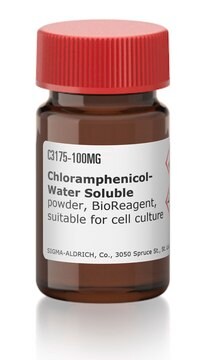C7795
Chloramphenicol
γ-irradiated
Sinónimos:
D-(−)-threo-2,2-Dichloro-N-[β-hydroxy-α-(hydroxymethyl)-β-(4-nitrophenyl)ethyl]acetamide, D-(−)-threo-2-Dichloroacetamido-1-(4-nitrophenyl)-1,3-propanediol, D-threo-2,2-Dichloro-N-[β-hydroxy-α-(hydroxymethyl)-4-nitrophenethyl]acetamide, Chloromycetin
About This Item
Productos recomendados
Nivel de calidad
esterilidad
γ-irradiated
Formulario
powder
pKa
~5.5
mp
149-153 °C (lit.)
solubilidad
absolute ethanol: 5-20 mg/mL (as a stock solution)
methanol: soluble (as a stock solution)
espectro de actividad antibiótica
Gram-negative bacteria
Gram-positive bacteria
mycobacteria
mycoplasma
Modo de acción
protein synthesis | interferes
temp. de almacenamiento
2-8°C
cadena SMILES
OC[C@@H](NC(=O)C(Cl)Cl)[C@H](O)c1ccc(cc1)[N+]([O-])=O
InChI
1S/C11H12Cl2N2O5/c12-10(13)11(18)14-8(5-16)9(17)6-1-3-7(4-2-6)15(19)20/h1-4,8-10,16-17H,5H2,(H,14,18)/t8-,9-/m1/s1
Clave InChI
WIIZWVCIJKGZOK-RKDXNWHRSA-N
Información sobre el gen
human ... CYP1A2(1544)
¿Está buscando productos similares? Visita Guía de comparación de productos
Categorías relacionadas
Descripción general
Aplicación
Acciones bioquímicas o fisiológicas
Modo de resistencia: Acetilación por cloranfenicol-acetiltransferasa (gen cat).
Precaución
Nota de preparación
Otras notas
Palabra de señalización
Danger
Frases de peligro
Consejos de prudencia
Clasificaciones de peligro
Carc. 2 - Eye Dam. 1 - Repr. 2
Código de clase de almacenamiento
11 - Combustible Solids
Clase de riesgo para el agua (WGK)
WGK 3
Equipo de protección personal
Eyeshields, Gloves, type P3 (EN 143) respirator cartridges
Elija entre una de las versiones más recientes:
¿Ya tiene este producto?
Encuentre la documentación para los productos que ha comprado recientemente en la Biblioteca de documentos.
Los clientes también vieron
Nuestro equipo de científicos tiene experiencia en todas las áreas de investigación: Ciencias de la vida, Ciencia de los materiales, Síntesis química, Cromatografía, Analítica y muchas otras.
Póngase en contacto con el Servicio técnico











